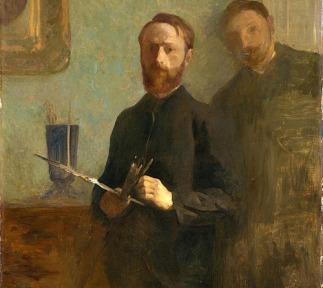For a generously bearded, self-styled “prophet” of Paris’s Belle Époque, Edouard Vuillard has a disappointingly uneventful biography. No swashbuckling or hard drinking for this mousy member of “Les Nabis,” a band of post-impressionist student painters galvanized by the works of Paul Gauguin. Vuillard lived with his mother, a widowed dressmaker, for sixty years. He never married. He had no conspicuous drug habits. He never lopped off one of his ears.
And if he seems an unlikely figure in the turn-of-the-century playground of Gauguin, André Gide, and Charles Baudelaire, this Catholic mama’s boy sounds like a bizarre choice for a special exhibition at New York City’s Jewish Museum.
Vuillard’s very domesticity was translated by his genius into startlingly vibrant depictions of interior spaces. His “Intimist” style was a kind of homebody impressionism, capturing in fragmented flecks the curtains and armchairs of Parisian apartments, rather than the haystacks and lily ponds of the French countryside. “I don’t do portraits,” he once insisted. “I paint people in their homes.” In his earliest works, the person he painted was almost always his mother, and the home was the modest flat they shared. But the banality of his recurring subject matter did not obscure his talents, and he soon attracted a far grander clientele. By the turn of the century, Vuillard had become the court painter of Paris’s privileged class, recording the Belle Époque at the height of its opulent glory. His eye for ornament, sharpened by decades among reams of fabric, left no ogee curve unrepresented. His society matrons are bordered by hazy jungles of pattern and color, his drawing rooms and bedchambers steeped in decor as exotic as the Polynesian paradises of Gauguin.
Indeed, so much attention has been paid to Vuillard the original “power-clasher”—the Vera Bradley of the Belle Époque—that the figures in his works have been reduced to mere hangers with faces. This is what makes the Jewish Museum’s exhibit so refreshing. “Edouard Vuillard: A Painter and His Muses, 1890–1940” invites the viewer to look beyond Vuillard’s abstract planes of pattern and allow his portrait-sitters to come into focus.
A closer examination reveals the surprising link between this Catholic painter and the Jewish Museum. With the exceptions of his mother and sister, Vuillard’s “muses” were almost exclusively Jewish. While Marie Vuillard’s dressmaking sparked her son’s passion for color and fabric, the friendships and financial support of Paris’s Jewish elite kept his artistic career alive.
Paradoxically, the Jewish Museum’s emphasis on the subjects of Vuillard’s portraits allows the viewer to appreciate his busy compositions even more. His discordant colors and patterns are, in fact, integral to his characterizations. Vuillard at once revels in his patrons’ luxury and chides them for it, commenting on their materialism, self-absorption, and ennui. Still, his lower-middle-class jabs at high society are usually tempered by the genuine fondness he felt for his rich friends. Perhaps the finest piece in the collection, Misia and Vallotton at Villeneuve (c. 1899), depicts Vuillard’s longtime friend Misia sitting idly at her kitchen table while the painter Félix Vallotton muses behind her, his eyes cast downward and his head boxed in by a painting on the wall behind him. Misia’s husband, Thadée, is cropped out of the scene almost entirely, recognizable only by the bearded chin, fingers, and round stomach that protrude into the painting from the left. The viewer sees just enough of his face to realize that he looks past Félix, though the two stand in the same plane. Misia faces a different direction altogether, ignoring the two men, ignoring even her little dog, who paws at her voluminous coat but is almost camouflaged in its folds. The swirling floral pattern on the wall behind them, the gruff blue of Félix’s coat, and the brown of Misia’s isolate each figure, suggesting alienation despite physical proximity. This, of course, is precisely Vuillard’s intention, proving him a painter of considerable psychological depth—not just a gifted connoisseur of wallpaper and chintz.
By 1914’s Marcelle Aron, Vuillard had reached the height of his gifts as a portraitist. Along the way, he had also made a baffling departure from his characteristically loose brushwork and frenzied technique. As many fellow Nabis embraced the abstraction of much early twentieth-century painting, Vuillard’s style receded into an unpopular conservatism. Cloudy banks of pattern gradually sharpened into pristine naturalism, and flattened planes of skin assumed organic shape through delicate modeling. Still, the hallmark of a Vuillard—his vibrant interiors—remained. Marcelle’s likeness sits on a blue-and-yellow-striped settee that clashes garishly with the green-and-purple paneling of her Parisian apartment’s walls. Each stripe and curve is distinctly rendered; even the periodical on Marcelle’s coffee table is identifiable. The sitter’s clothing, too, is a departure from the indiscriminate flood of patterns one sees in Misia and Vallotton at Villeneuve. In stark contrast to her surroundings, Marcelle is dressed in an ensemble of brown and black, and wears a simple strand of pearls. The vertical emphasis of the upholstery and latticed wall design seems to confine her like a caged bird. Unlike Misia, Marcelle manages to extend a gesture of affection to the imploring Pomeranian beside her, but the note of boredom in her expression and posture indicate that she has not entirely escaped the malaise of privilege.
Marcelle was the wife of the writer Tristan Bernard and a key member of Vuillard’s social circle. She figured most prominently in the painter’s life as the cousin and close friend of Lucy Hessel, Vuillard’s lover and primary muse. (For a man who lived with his mother, Vuillard had a remarkably active love life.) Vuillard’s relationship with Lucy lasted until his death, though their final years together were marred by tragedy. The couple witnessed the swift end to the Belle Epoque’s optimistic frivolity with the devastation of World War I and the Great Depression. By the start of World War II, Vuillard’s Jewish patrons had lost their wealth and social standing. Some would also lose their lives. The caption accompanying a charming portrait of three-year-old Claude Bernheim de Villers, the son of Vuillard’s art dealer, adds that the boy would perish in Auschwitz less than forty years later. When the Nazis invaded France, Vuillard fled to Brittany with the Hessels, where he died in 1940. Paris’s elite Jewish culture had collapsed, never to be entirely restored, but Vuillard’s portraits would remain as a record of its former glories.
Vuillard's 'Self-Portrait With Waroquy,' courtesy The Jewish Museum


